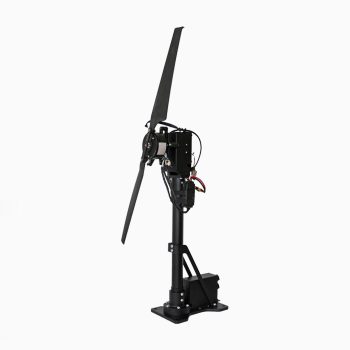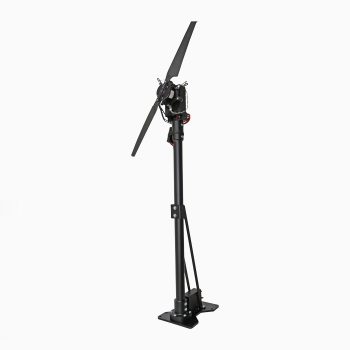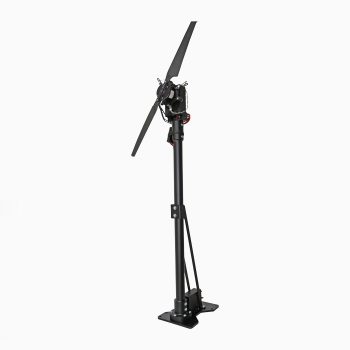How Does a Propulsion System Work in an Aircraft?
An aircraft propulsion system is responsible for generating the force required to move the aircraft through the air. The most common type of propulsion system used in modern aircraft is the jet engine, although some smaller aircraft still use piston engines.
A jet engine works by taking in air from the atmosphere and compressing it using a series of fans or compressors. The compressed air is then mixed with fuel and ignited, which causes a rapid expansion of gases that drives a turbine, generating thrust.
The basic components of a jet engine include:
- Inlet: The inlet is the first component of the engine and is responsible for capturing air from the atmosphere and directing it into the engine.
- Compressor: The compressor is a series of fans that compresses the air as it enters the engine. This compressed air is then mixed with fuel to create a combustible mixture.
- Combustion chamber: The combustion chamber is where the compressed air and fuel are mixed and ignited. This causes a rapid expansion of gases that drives the turbine.
- Turbine: The turbine is driven by the expanding gases from the combustion chamber and is connected to the compressor by a shaft. The turbine drives the compressor and also generates thrust.
- Exhaust: The exhaust is the final component of the engine and is responsible for directing the exhaust gases out of the engine and into the atmosphere.
The amount of thrust generated by a jet engine depends on a variety of factors, including the size and design of the engine, the amount of fuel being burned, and the speed at which the aircraft is traveling. By adjusting these factors, pilots can control the amount of thrust being generated by the engine and therefore control the speed and altitude of the aircraft.
If you want to get more detailed information about this subject, we have written “How Does a Propulsion System Work in an Aircraft?” You can check our article titled
What are the Key Components of a Propulsion System and What are Their Functions?
A propulsion system is responsible for generating the force required to move an object, such as an aircraft or a spacecraft, through a medium, such as air or space. The key components of a propulsion system and their functions depend on the specific type of propulsion system being used. Here are some of the key components of different types of propulsion systems and their functions:
- Jet engine: A jet engine is a type of internal combustion engine that generates thrust by the combustion of fuel and air. The key components of a jet engine include the inlet, compressor, combustion chamber, turbine, and exhaust. The inlet captures air from the atmosphere, the compressor compresses the air, the combustion chamber mixes and ignites the compressed air and fuel, the turbine drives the compressor and generates thrust, and the exhaust directs the exhaust gases out of the engine.
- Rocket engine: A rocket engine generates thrust by expelling exhaust gases out of a nozzle at high velocity. The key components of a rocket engine include the combustion chamber, nozzle, fuel pump, and oxidizer pump. The combustion chamber mixes and ignites fuel and oxidizer to produce exhaust gases, the nozzle directs the exhaust gases and accelerates them to high velocity, the fuel pump pumps fuel to the combustion chamber, and the oxidizer pump pumps oxidizer to the combustion chamber.
- Electric propulsion system: An electric propulsion system generates thrust by accelerating charged particles, such as ions or electrons, using an electric field. The key components of an electric propulsion system include the power supply, ionizer, accelerator, and exhaust. The power supply provides electricity to the ionizer, which ionizes a propellant gas, the accelerator accelerates the charged particles using an electric field, and the exhaust directs the accelerated particles out of the engine.
In summary, the key components of a propulsion system depend on the specific type of propulsion system being used, but generally include components for generating and directing exhaust gases, mixing and igniting fuel and oxidizer, and accelerating charged particles using an electric field.
What are the Different Types of Propulsion Systems Used in Aviation?
There are several different types of propulsion systems used in aviation, each with its own advantages and disadvantages. Here are some of the most common types:
- Jet engines: Jet engines are the most common type of propulsion system used in aviation today. They generate thrust by taking in air, compressing it, mixing it with fuel, and igniting it to create a high-speed exhaust stream. Jet engines are efficient and powerful, but they are also expensive to build and maintain.
- Turboprop engines: Turboprop engines are similar to jet engines, but they use the exhaust gases to drive a propeller rather than generating thrust directly. Turboprop engines are quieter and more fuel-efficient than jet engines, but they are not as powerful and are typically used in smaller aircraft.
- Piston engines: Piston engines are a type of internal combustion engine that uses reciprocating motion to generate power. They are used in smaller aircraft, such as small planes and helicopters, and are generally less powerful and less efficient than jet engines.
- Ramjets: Ramjets are a type of jet engine that do not have any moving parts. They rely on the forward motion of the aircraft to compress incoming air, which is then mixed with fuel and ignited to generate thrust. Ramjets are very fast and efficient at high speeds, but they are not effective at low speeds or at high altitudes.
- Scramjets: Scramjets are a type of jet engine that are similar to ramjets, but they operate at even higher speeds. They are currently in development and have the potential to revolutionize aviation by enabling hypersonic flight.
- Electric propulsion systems: Electric propulsion systems use electric power to generate thrust, rather than combustion. They are still in the early stages of development, but have the potential to be more efficient and environmentally friendly than traditional combustion engines.
In summary, the different types of propulsion systems used in aviation include jet engines, turboprop engines, piston engines, ramjets, scramjets, and electric propulsion systems. Each type has its own strengths and weaknesses, and is used in different types of aircraft depending on their size, speed, and other requirements.
How is Maintenance Done for a Propulsion System?
Maintenance of a propulsion system is critical for ensuring safe and efficient operation of an aircraft. The specific maintenance requirements and procedures vary depending on the type of propulsion system, but here are some general steps that are typically involved:
- Inspection: Regular inspections of the propulsion system are important for detecting any signs of wear or damage. This can include visual inspections, as well as non-destructive testing methods such as ultrasonic or X-ray inspection.
- Cleaning: Keeping the propulsion system clean is important for maintaining its performance and preventing corrosion. This can involve cleaning the exterior of the engine, as well as removing any debris or buildup from the internal components.
- Lubrication: Proper lubrication is essential for ensuring the moving parts of the propulsion system operate smoothly and efficiently. This can involve adding lubricants to the engine oil or grease fittings.
- Component replacement: Over time, certain components of the propulsion system may need to be replaced due to wear or damage. This can include parts such as bearings, seals, or turbine blades.
- Overhaul: Depending on the type of propulsion system, a more extensive overhaul may be required at certain intervals. This can involve disassembling and inspecting the engine components, cleaning and repairing any damage, and reassembling the engine to its original specifications.
- Testing: After maintenance is performed on the propulsion system, it must be tested to ensure that it is operating correctly. This can involve running the engine at different power levels and speeds, as well as performing other tests such as vibration analysis or balance testing.
Overall, maintenance of a propulsion system is a complex and detailed process that requires specialized knowledge and training. It is essential for ensuring the safety and reliability of an aircraft, and should be performed by trained professionals following established procedures and guidelines.
What are the Safety Considerations for Propulsion Systems in Aviation?
Safety considerations for propulsion systems in aviation are of utmost importance, as any issues with the propulsion system can have serious consequences for the safety of the aircraft and its passengers. Here are some key safety considerations for propulsion systems:
- Fire safety: The high temperatures and combustible materials used in propulsion systems make them a potential fire hazard. Therefore, proper fire safety procedures and equipment, such as fire extinguishers, must be in place and crew members should be trained to handle potential fire situations.
- FOD (Foreign Object Damage) prevention: FOD is a significant safety concern for propulsion systems. Foreign objects, such as debris or birds, can be sucked into the engine and cause serious damage. Therefore, procedures must be in place to prevent FOD, such as regular inspections of the runway and surrounding areas, and proper maintenance of the aircraft.
- Exhaust safety: The exhaust gases generated by the propulsion system can be hazardous to both the aircraft and ground personnel. Therefore, proper exhaust safety procedures, such as installing exhaust deflectors and warning signs, must be in place.
- Maintenance safety: Maintenance of propulsion systems involves working with high temperatures, pressures, and potentially hazardous materials. Therefore, proper safety equipment and procedures must be in place to ensure the safety of maintenance personnel.
- Pilot training: Pilots must be trained on the proper operation of the propulsion system and how to respond to any issues or malfunctions that may occur during flight.
- Emergency procedures: In the event of a propulsion system malfunction, emergency procedures must be in place to ensure the safety of the aircraft and its passengers. This includes procedures for emergency landings, evacuations, and other contingencies.
Overall, safety considerations for propulsion systems in aviation are critical for ensuring the safe and reliable operation of aircraft. Proper procedures, training, and equipment must be in place to mitigate potential hazards and respond to any issues that may arise.
What are the Advantages and Disadvantages of Various Propulsion Systems?
There are several types of propulsion systems used in aviation, each with their own advantages and disadvantages. Here are some of the most common propulsion systems and their pros and cons:
Piston Engine:
Advantages:
- Low initial cost
- Good fuel efficiency at lower altitudes
- Well-established technology
Disadvantages:
- Limited power output
- Less efficient at higher altitudes
- More maintenance-intensive than other propulsion systems
Turboprop Engine:
Advantages:
- Good fuel efficiency at moderate altitudes
- Better power output than piston engines
- Quieter than jet engines
Disadvantages:
- Less efficient than jet engines at high altitudes and speeds
- Limited maximum altitude
- Higher maintenance costs than piston engines
Turbofan Engine:
Advantages:
- High fuel efficiency at high altitudes and speeds
- Good power output
- Quieter than other jet engines
Disadvantages:
- Higher initial cost than piston and turboprop engines
- Less efficient at lower altitudes and speeds
- More complex than other propulsion systems, leading to higher maintenance costs
Turbojet Engine:
Advantages:
- High speed and altitude capability
- Good power output
- Well-established technology
Disadvantages:
- Poor fuel efficiency at lower altitudes and speeds
- Very noisy
- Higher maintenance costs than other propulsion systems
Overall, the choice of propulsion system for an aircraft depends on factors such as the mission requirements, cost considerations, and performance needs. Each propulsion system has its own advantages and disadvantages, and it is up to the aircraft manufacturer and operator to choose the best system for their specific needs.





